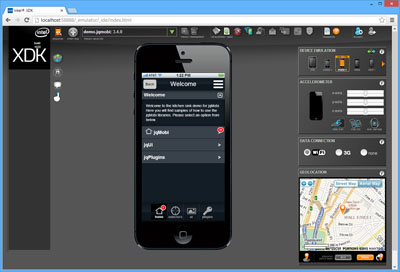Intel Software Conference 2013
This article originally appeared in the Summer 2013 issue of HardCopy magazine.

The Intel Cross Developer Kit (XDK): a browser-based environment for building HTML5 applications that run on mobile devices.
The annual Intel Software Conference is always worth attending, and not just for its location (this year, a converted chateau just outside Chantilly). Intel has been the driving force behind the personal computer industry from the beginning, and introduced this series of events in 2006 as a way of alerting developers to the need to master the parallel programming techniques that will allow them to take advantage of multi-core processors.
The industry has changed considerably in the intervening years, and so has this conference. Initially the focus was on Intel Core processors on the desktop and Intel Xeon in the servers. Intel’s main weapon here has been Parallel Studio. Introduced in 2009, this collection of tools and libraries is aimed primarily at optimising C/C++ code for multi-core processing.
Then, in 2012, Intel found itself challenged by NVIDIA which had realised that its graphics cards, some of which boasted graphics processors with more than 1,000 cores, could do more than generate graphics. Intel’s response was its Many Integrated Core (MIC) initiative which manifested as Xeon Phi, a multi-core co-processor architecture that could offer more power, albeit at a higher price.
A year later and the challenge has come from ARM which produces the processors that are to be found in almost every modern mobile and tablet. Intel’s strategy for this growing market has been the Atom range of processors which first appeared in 2008. However the Atom has yet to make serious inroads which, coupled with reports of falling sales in the desktop market, could be problematic for Intel.
Which is why Thomas Zipplies opened this year’s event with presentations devoted to the two tools that lie behind a new strategy for building Intel’s presence in this market.
The first is Intel System Studio which complements Parallel Studio in offering an integrated suite of tools designed to help the developer build applications for mobile and embedded devices. The suite supports Intel Atom, Core and Xeon processors, as well as Wind River Linux. There was even talk of a System Studio for Android.
More intriguing is the Intel HTML5 Development Environment. This comes in two parts: the XDK (Cross Development Kit) plug-in for the Chrome browser which presents a visual environment in which to develop HTML5 apps for mobile devices; and a cloud-based service called App Dev Center that will deploy the results to Apple’s App Store, Google Play, Windows Store, Chrome Store and even Facebook, should you so desire. Both are free of charge.
Such an approach removes the need for developers to tackle the native SDKs and the intricacies of deploying to each of these “walled gardens”, as Zipplies dubbed them. Why is Intel doing this? Because it encourages developers to use an open platform to develop mobile apps, and that will make it easier for Intel to build a presence. I look forward to evaluating their impact at next year’s conference.

I do not know whether it’s just me or if everyone else encountering issues with your website.
It appears as if some of the text within your posts are running
off the screen. Can somebody else please comment and let me know if
this is happening to them too? This may be a issue with my browser because I’ve had this
happen before. Appreciate it
LikeLike
Sorry for late reply, but I’ve been away for the past few weeks. I’ve tested this on a number of browsers and machines, and not seen a problem. What browser/machine are you using?
LikeLike